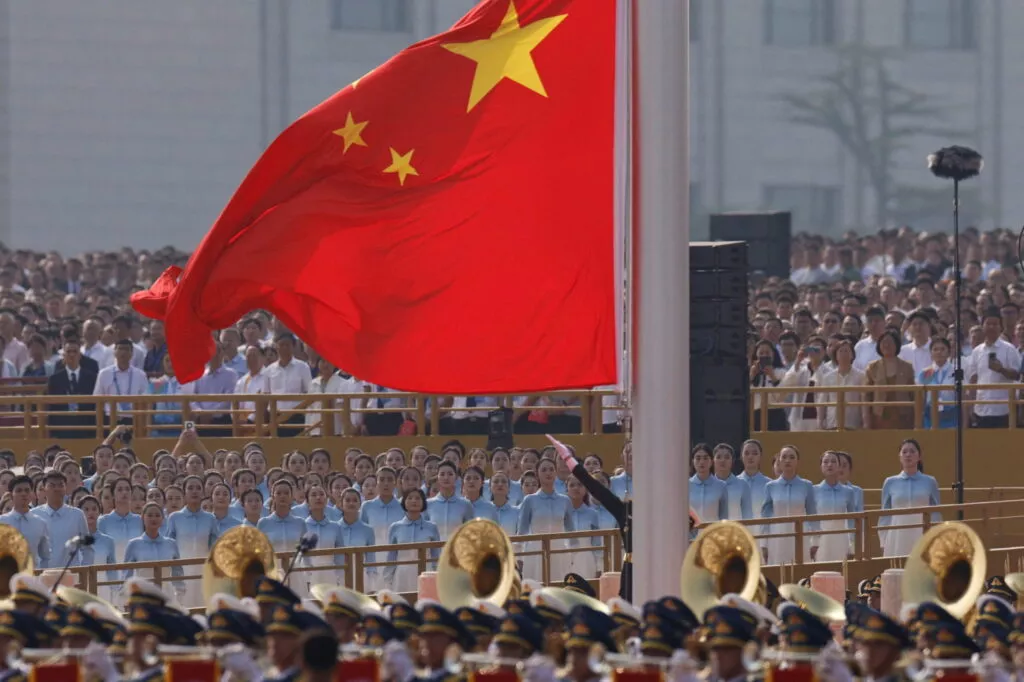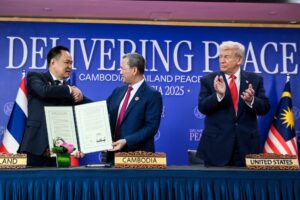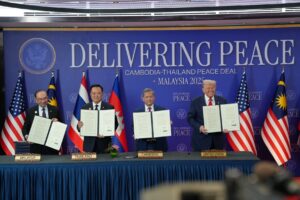China’s defence white paper sets sights on Southeast Asia
On 12 May 2025, China released a new defence white paper: ‘China’s National Security in the New Era’. Adopting a ‘holistic’ approach to security, considering the latest global developments while also drawing from historical experience, it carries repercussions both locally and globally, with significant implications for Southeast Asian states.
This 2025 defence white paper (2025 DWP) clearly defines Beijing’s vision and objectives for the ‘new era’. For China today, ‘new era’ denotes the evolution of the Asia Pacific economic construct into a rigid, competitive and security-oriented Indo-Pacific strategy, led by the United States and its allies. This poses a challenge to Beijing’s regional and global ambitions — influenced by the tianxia (all under heaven) political philosophy — where harmony and stability stem from a prosperous and powerful China.
The 2025 DWP’s primary focus is to situate China at the centre of the regional and global order. It conveys China’s intentions to its Asian neighbours and extra-regional actors who have begun to align with the US-led Indo-Pacific strategy. The resounding message is that peace, stability and prosperity in a hierarchical Asia will emanate from China’s leadership. Beijing asserts that the development and stability of China and its neighbourhood are synonymous in a shared future.
China’s continued use of ‘Asia Pacific’ in its official statements, including the 2025 DWP, suggests a clear opposition to the US Indo-Pacific strategy. China aims to prevent the Indo-Pacific concept from becoming a rallying point for neighbouring states and the broader region to form a common front against them. Beijing seeks to present itself as a holistic economic and security provider for the region and an opportunity for development, rather than a common threat. This is crucial to securing greater regional support, particularly as Trump 2.0 disregards economic and socio-cultural engagement to counter China.
But this does not mean the United States will allow China free rein across Asia and the Pacific. US Secretary of Defense Pete Hegseth reassured America’s Asian allies that their alliances with the United States are ‘iron-clad’, the ‘cornerstone of peace and security’ and that ‘America First does not mean America Alone’.
This situation pressures Southeast Asian states to choose their economic development and security provider, which is contrary to the region’s intentions. To further complicate matters, there are potential supporters of China’s vision, such as Cambodia and Laos. Historically, such choices have intensified the political, economic and strategic chasm within the region, impacting the collective identity of ASEAN — as seen in their first-ever deadlock over a joint statement in 2012.
The 2025 DWP also sets out China’s core national interests — including the reunification of Taiwan and stability in Xinjiang, Tibet, Hong Kong, Macau and the South China Sea. China maintains a position that justifies the use of force to defend these interests if necessary. This could exacerbate regional and global tensions. The 2025 DWP also indicates that, while Beijing advocates for consultation, it remains indifferent towards the timely finalisation of a China–ASEAN Code of Conduct in the South China Sea, whereas ASEAN aspires to conclude negotiations by 2026.
Part of Beijing’s strategy in the South China Sea involves convincing claimant states to settle for bilateral negotiations. This approach may prompt the region to seek economic and security diversification with extra-regional powers to balance economic overdependence and protect their foreign policy autonomy and territorial integrity.
Nations directly affected by China’s expansive maritime claims exhibit varying threat perceptions, resulting in common yet differentiated responses across Southeast Asia. Vietnam is expected to strengthen security cooperation with extra-regional powers while reassuring Beijing that such actions are not aimed against China. Conversely, the Philippines’ policy reveals a closer security alignment with the United States and a hardening stance against China.
The 2025 DWP also suggests a shift in China’s security outlook. China’s proposals for the Global Development Initiative (2021), Global Security Initiative (2022) and Global Civilization Initiative (2023) imply that Beijing may be assuming a broader role — beyond trade — to address global challenges. The underlying goal is to reduce US strategic influence in regional economic and security affairs. Southeast Asia is grappling with the repercussions of Trump’s tariffs and the United States’ unpredictable commitments in the region. This opens the door for China to position itself as a provider of stability.
But this is insufficient for China to win over the region. Southeast Asia still places strategic trust in the United States. The State of Southeast Asia: 2025 Survey Report from the ISEAS–Yusof Ishak Institute highlights that the United States has a greater economic and strategic impact than China. Yet Southeast Asian states are also aware that US engagement has been inconsistent since the end of the Cold War and will continue to welcome all major powers to the region as a strategic buffer.
By pursuing a balanced approach, Southeast Asian states can mitigate the effects of erratic US engagements, serve as a bulwark against China’s excesses and expand their pool of economic, strategic and security options. Southeast Asian states must strive to cultivate pragmatic relationships that address their domestic development concerns while ensuring maximum strategic autonomy in foreign affairs.
Ananta Swarup Bijendra De Gurung is Assistant Professor at the Centre for Indo-Pacific Studies, School of International Studies, Jawaharlal Nehru University.
Source: East Asia Forum




